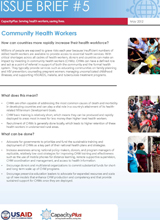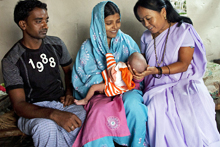
How Can Countries More Rapidly Increase Their Health Workforce?
On May 31 and June 1, USAID will host the Global Health Evidence Summit on Community and Formal Health System Support for Enhanced Community Health Worker Performance in Washington, DC. The summit is part of a process that will result in key products and an evidence-to-action plan for implementation. CapacityPlus’s Maurice Middleberg and James McCaffery are involved in this process and will participate in the summit.
In advance of the summit, CapacityPlus announces the publication of Issue Brief #5, Community Health Workers. This brief presents an overview of issues related to community health workers and human resources for health along with suggested actions, key considerations, and resources. Millions of people are exposed to grave risks each year because insufficient numbers of skilled health workers are available to provide access to essential health services. With critical shortages across all cadres of health workers, donors and countries can make an impact by investing in community health workers (CHWs). CHWs can have a defined role and act as a point of referral in support of both the community and the formal health system. They typically provide services such as educating communities on family planning and HIV prevention; counseling pregnant women; managing uncomplicated childhood illnesses; and supporting HIV/AIDS, malaria, and tuberculosis treatment programs.
Millions of people are exposed to grave risks each year because insufficient numbers of skilled health workers are available to provide access to essential health services. With critical shortages across all cadres of health workers, donors and countries can make an impact by investing in community health workers (CHWs). CHWs can have a defined role and act as a point of referral in support of both the community and the formal health system. They typically provide services such as educating communities on family planning and HIV prevention; counseling pregnant women; managing uncomplicated childhood illnesses; and supporting HIV/AIDS, malaria, and tuberculosis treatment programs.
What does this mean?
- CHWs are often capable of addressing the most common causes of death and morbidity in developing countries and can play a vital role in a country’s attainment of its health-related Millennium Development Goals.
- CHW basic training is relatively short, which means they can be produced and rapidly deployed to areas most in need for less money than higher-level health workers.
- Recruitment of CHWs is generally done locally, which leads to higher retention of these health workers in underserved rural areas.
What can be done?
- Advocate for governments to prioritize and fund the sustainable training and deployment of CHWs as a key part of their national health plans and strategies.
- Increase awareness among national policy-makers, donors, and program managers of replicable, relatively low-cost strategies for improving CHW training and effectiveness such as the use of mobile phones for distance learning, remote supportive supervision, CHW coordination and management, and access to health information.
- Encourage donors and multilateral organizations to commit substantial funds for short- and long-term scale up of CHW programs.
- Encourage preservice education leaders to advocate for expanded resources and scale up of new models that enhance CHW production and competency and that provide sustained support for CHWs once they are deployed.
Key considerations
- CHW programs work best when CHWs are positioned as the frontline point of referral between the community and the formal health system, and are appropriately supported to be able to fulfill this essential function. Appropriate support includes the following, in combination:
 – CHW programs need to be owned and driven by the community and responsive to community needs, with CHWs supported by and accountable to the communities they serve.
– CHW programs need to be owned and driven by the community and responsive to community needs, with CHWs supported by and accountable to the communities they serve.
– CHWs need to receive adequate management and professional support from the formal health system and be appropriately compensated for their work.
- CHWs provide optimal access to services by being integrated within a primary health care team. In Brazil, for example, family health teams serving communities include four or more paid CHWs, a nurse assistant, a nurse, and a physician.
- An enabling work environment is critical to the productivity of CHWs. Any combination of too many job responsibilities, too many households to serve, lack of transportation, inadequate equipment and supplies, and weak supervision will reduce their productivity and effectiveness.
- Scaling up CHW programs necessitates strong leadership, political support, and resources. Programs can often under-perform or fail due to poor planning, insufficient funding, and unrealistic expectations.
See Issue Brief #5 for selected resources and more information. Previous CapacityPlus Issue Briefs focus on the topics of retention, health worker information systems, HR management, and faith-based organizations.
Related items:
Photo by Trevor Snapp. (Community health worker with clients in India)


